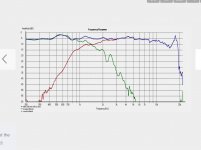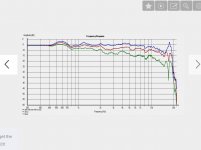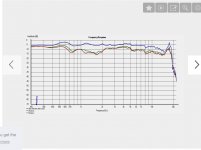I would like to go on a little more about caps. First of all DA, and harmonic (or IM)distortion are SEPARATE problems, and have to be measured differently. Ignore DA if you want, and live in ignorance. No matter what we try, there is no IDEAL cap for audio. Some caps can be fairly neutral, like REL-CAP's, some can add a pleasant change, like some of the very expensive, oil filled caps. Others can add a small change with the best, and a really edgy change for the worst. Before some of us actually evaluated caps more thoroughly for audio performance, we thought much like most here today, but after evaluating and measuring hundreds of different caps, you really find that they can be a problem, usually. For the record, many independent manufacturers and modifiers have found REL-CAP's to sound just about the best. They are not the most attractive, or the most expensive, but they are well engineered, and that seems to make a difference. I use REL-CAP's, have for 40 years now, I use them with the best Parasound, Constellation, the CTC Blowtorch, and the Vendetta Research SCP-2, and just about anything I get my hands on. I am not alone, as PS audio is using REL in their RIAA networks, just like I do. Yet, I hardly know those people. Why? Because they sound better? Probably.
Unfortunately, Rel is now shut down to the rest of the world, and probably even me, as Dave Wilson's company bought it and moved it to UTAH, so that they would have a continuous supply of crossover caps of sufficient quality. You can still buy some at Michael Percy's mail-order service.
Now what about DA? Back 35 years ago, I measured hundreds of different kinds of caps, virtually everything that I could get a hold of. Walt and I published a few examples in that article that we shared.
Now some here do not realize that DA does not easily go away as easily as normal non-linear distortion. Yes, it can go down with light loading, but it doesn't go easily away. Just look at Fig 1 and Fig 6 of the page I am putting up here. It is the SAME CAP with different loading, yes, 450 ohms in Fig 1, and 50,000 ohms in Fig 6,. That shows that DA is going to be present in virtually all audio music.
Unfortunately, Rel is now shut down to the rest of the world, and probably even me, as Dave Wilson's company bought it and moved it to UTAH, so that they would have a continuous supply of crossover caps of sufficient quality. You can still buy some at Michael Percy's mail-order service.
Now what about DA? Back 35 years ago, I measured hundreds of different kinds of caps, virtually everything that I could get a hold of. Walt and I published a few examples in that article that we shared.
Now some here do not realize that DA does not easily go away as easily as normal non-linear distortion. Yes, it can go down with light loading, but it doesn't go easily away. Just look at Fig 1 and Fig 6 of the page I am putting up here. It is the SAME CAP with different loading, yes, 450 ohms in Fig 1, and 50,000 ohms in Fig 6,. That shows that DA is going to be present in virtually all audio music.
Attachments
Last edited:
.As nothing is perfect in the universe in which we live, as we dont know all of the laws of physics, as the materials our technology use are not perfect either, neither the way we assemble them, as we do not know a lot about psychoacoustics and physics (it should be stupid to believe this), there is an element of 'violin making' in the construction of audio systems. Violin making is not just a question of formulas, and limiting oneself to "objective" datas is an attitude of a small civil servant
What do you think, can a ‘violin maker’ (that is, a golden ear that has no clue about electronics, physics, etc...) create a great audio system?
For DIY use, if high impedances can be acceptable, for small values like RIAA, air variable caps give very high performance. It would take a shoebox full to make a coupling cap at 10K Ohm-ish impedances though.
All good fortune,
Chris
ps: suggested by a friend of Wavebourn's, whose name I'll need to look up for proper credit
All good fortune,
Chris
ps: suggested by a friend of Wavebourn's, whose name I'll need to look up for proper credit
Has binaural recording been mentioned? if you make a binaural recording using two microphones inside a dummy head (with proper "ears" and such) you can get a "better" recording, and it will "work" if played back through headphones. I can't imagine that playing back through speakers in the room could possibly as much like the original person in the room as would be played back through headphones.Microphones are better than loudspeakers, that is no the issue. When you record a sound there are room interactions, positional differences and source directional differences.
If I listen to just a person talking in a room the high frequencies are more directional and some low frequencies will still reach me due to reflective surfaces.
If I record that person in a studio the microphone does not have the same coverage angle as my ears and often the room has less or no reflections.
As has been covered earlier (I missed the last 100 posts or so) his playing-back-through-the-room thing is flawed from the start, if the idea is to reproduce the exact sound of hearing the person in the room. Not sure how or why this idea got so much traction.
Scot showed a write up a few years ago where DA was modeled using IIRC an RC network in parallel with the main signal cap. If you ran a distortion plot there was no effect. If you put an assymetrical wave through the setup, you got some of the artifacts you see in the plots above.
I don’t know what the outcome of that exchange was (can’t recall) but we should resurrect it as it’s important we recycle through this stuff every few years
😉
I don’t know what the outcome of that exchange was (can’t recall) but we should resurrect it as it’s important we recycle through this stuff every few years
😉
NPO/COG are the modern go to cap for RIAA networks.
Available in tight tolerances, 1206 and smaller so compact layouts are possible to reduce hum/noise etc.
You should try them sometime.
Great also for compensation in power amps since 1000 V types are also available
Available in tight tolerances, 1206 and smaller so compact layouts are possible to reduce hum/noise etc.
You should try them sometime.
Great also for compensation in power amps since 1000 V types are also available
What do you think, can a ‘violin maker’ (that is, a golden ear that has no clue about electronics, physics, etc...) create a great audio system?
Can a 'meter reader' (that is, someone who does it strictly by the books and who has no clue about hearing, music, etc...) create a great audio system?
NPO/COG are the modern go to cap for RIAA networks.
Available in tight tolerances, 1206 and smaller so compact layouts are possible to reduce hum/noise etc.
You should try them sometime.
Great also for compensation in power amps since 1000 V types are also available
Thanks, sounds like a plan. Personally, I'm in a unique situation of having literally hundreds of the old Mallory and MIAL polystyrene see-thru's in bins. Not enough lifetime left to put a dent in 'em. Maybe not audiophile approved, but plenty good enough for my old ears. (Use heatsinks when soldering!)
Much thanks, as always,
Chris
That should give you all the SPL you need!
Yes, I’m trying to figure out a better mousetrap for the dsp end of things, looking like a mini dsp shd is in the lead.
Already have a crown xls 2002 for subs, gonna run the 10” drivers with the my yammie. And the Hint has a HT bypass so I can run the tweets from that (should stay in class A for the most part!)
So except for a cap on each tweet it’ll be all active.
I didn't want to make that comment earlier but now that I see you are ordering a mini DSP: MTM's are hard and big MTM's are impossible. The problem is that the two M's will have a very narrow horizontal lobe the higher the frequency becomes. The right thing to do this is to put a 6 dB low pass filter on the top M, after the normal bandpass.
As I wrote, no load at otput. Just to show "capacitor distortions"..With load it looks like this, in picture is also no load measurement and card loopback.
Missed that, really great amp!
Thanks a lot Simon. I suppose no noticeable distortion in the source and no rejection of the 700hz level signal before measurement ?
Actually it was the bridge technique so the test signal was suppressed.
Not using the bridge technique of course limits you to the test equipment limits and any components used in it.
Last edited:
I would like to go on a little more about caps. First of all DA, and harmonic (or IM)distortion are SEPARATE problems, and have to be measured differently. Ignore DA if you want, and live in ignorance. No matter what we try, there is no IDEAL cap for audio. Some caps can be fairly neutral, like REL-CAP's, some can add a pleasant change, like some of the very expensive, oil filled caps. Others can add a small change with the best, and a really edgy change for the worst. Before some of us actually evaluated caps more thoroughly for audio performance, we thought much like most here today, but after evaluating and measuring hundreds of different caps, you really find that they can be a problem, usually. For the record, many independent manufacturers and modifiers have found REL-CAP's to sound just about the best. They are not the most attractive, or the most expensive, but they are well engineered, and that seems to make a difference. I use REL-CAP's, have for 40 years now, I use them with the best Parasound, Constellation, the CTC Blowtorch, and the Vendetta Research SCP-2, and just about anything I get my hands on. I am not alone, as PS audio is using REL in their RIAA networks, just like I do. Yet, I hardly know those people. Why? Because they sound better? Probably.
Unfortunately, Rel is now shut down to the rest of the world, and probably even me, as Dave Wilson's company bought it and moved it to UTAH, so that they would have a continuous supply of crossover caps of sufficient quality. You can still buy some at Michael Percy's mail-order service.
Now what about DA? Back 35 years ago, I measured hundreds of different kinds of caps, virtually everything that I could get a hold of. Walt and I published a few examples in that article that we shared.
Now some here do not realize that DA does not easily go away as easily as normal non-linear distortion. Yes, it can go down with light loading, but it doesn't go easily away. Just look at Fig 1 and Fig 6 of the page I am putting up here. It is the SAME CAP with different loading, yes, 450 ohms in Fig 1, and 50,000 ohms in Fig 6,. That shows that DA is going to be present in virtually all audio music.
I suppose this scope was AC coupled for these measurements, also for the perfect square waves on top. What was used for AC coupling .... ? So, a square wave can survive a coupling cap. No further questions.
Can a 'meter reader' (that is, someone who does it strictly by the books and who has no clue about hearing, music, etc...) create a great audio system?
Was Peter Walker's gear used in studio's? Of course he wrote his own book, but other than that, he was a meter reader pur sang.
MTM is a broken concept. Will always have uneven off-axis FR and and power curve is not 100% so you actually loose some effect at some frequencies. Look elsewhere, nothing to see here... but a "cool" look. Hype.
//
//
Can a 'meter reader' (that is, someone who does it strictly by the books and who has no clue about hearing, music, etc...) create a great audio system?
Define “great” in this context.
... Of course he wrote his own book...
Well said.
Peter Walker was a great man; I met and spoke to him several times, and it was always a pleasure. He once declared publicly: "I'm not an academic, I'm an industrial": so much so for the "book" part. The fact he was also a musician didn't hurt.
I've had many ESL57's: single (mono), double (stereo), stacked à la HQD (yes, including the original Decca ribbon tweeters). I still have a pair of '57 as my main speakers; I bought them new in the '80's, and I've still haven't heard anything that compels me to change. That kind of achievement doesn't come from meter reading.
Define “great” in this context.
A simple analogy I hope you can grasp: look up some pictures of the Niagara Falls, study them closely, then go there and check out the real thing.
Last edited:
Thought is i’ll be able to listen at my normal level of 95db @ lp without anything breaking a sweat.....and then when I want to get crazy there’s still plenty of pedal left.That should give you all the SPL you need!
I didn't want to make that comment earlier but now that I see you are ordering a mini DSP: MTM's are hard and big MTM's are impossible. The problem is that the two M's will have a very narrow horizontal lobe the higher the frequency becomes. The right thing to do this is to put a 6 dB low pass filter on the top M, after the normal bandpass.
Thx for your input vac, the whole idea is to keep the room out of the equation as much as possible.....I bookmarked the polars but can’t find them now,they weren’t bad though. Way better horizontal than vertical.....all of my critical listening is done seated anyhow and tweeters will be just below ear level.
Low pass on the top is definately easy enough to experiment with....but judging from the critiques of those who have built them horizontal was not an issue.
We shall see I suppose, if I don’t like them I could try mmt .
Attachments
Last edited:
I can't help thinking there is something off with the way you are measuring the SPL
What Noises Cause Hearing Loss? | NCEH | CDC
What Noises Cause Hearing Loss? | NCEH | CDC
- Status
- Not open for further replies.
- Home
- Member Areas
- The Lounge
- John Curl's Blowtorch preamplifier part III



